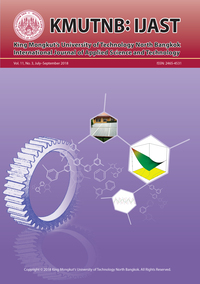The Effectiveness of Dengue Vaccine and Vector Control: Model Study
Main Article Content
Abstract
The first of commercial dengue vaccine called Dengvaxia, was approved in Mexico, Brazil and the several countries. The objective of this study is to estimate the effectiveness of the vaccine to number dengue infection by using mathematical model of dengue transmission with multiple serotypes of dengue virus. The vaccine is given to a certain part of population in the community and the number of dengue infections and incidences is then calculated. The combination of vector control methods and vaccination is also evaluated. The results shown that the cooperation between both programs is reduced the number of dengue infection by more than 90% with 50% of vaccine coverage. The vaccination or vector control programs alone are unable to eliminate dengue infection from community.
Article Details
References
[2] Centers for Disease Control and Prevention. (2016, Aug.). Dengue and the Aedes aegypti mosquito. Centers for Disease Control and Prevention, USA [Online]. Available: http:// www.cdc.gov/dengue/
[3] S. Murrell, S. Wu, and M. Butler, “Review of dengue virus and development of a vaccine,” Biotechnology Advances, vol. 29, no. 2, pp. 239–247, 2011.
[4] Asian Development Bank and World Health Organization. (2016, Jan.). Managing Regional Public Goods for Health Community-Based Dengue Vector Control. World Health Organization. Geneva, Switzerland [Online]. Available: http:// www.adb.org/publications/ managing-regionalpublic- goods-health-community-based-denguevector- control
[5] N. Achee, F. Gould, T. Perkins, R. Reiner Jr, and A. Morrison, “A critical assessment of vector control for dengue prevention,” PLOS Neglected Tropical Diseases, vol. 80, no. 5, pp. e0003655, 2015.
[6] Sanofi Pasteur. (2016, Jan.). Dengvaxia, World’s First Dengue Vaccine, Approved in Mexico. Swiftwater, USA [Online]. Available: http://www. sanofipasteur.com/en/articles/dengvaxia-worlds- first-dengue-vaccine-approved-in-mexico.aspx
[7] B. Guy and N. Jackson, “Dengue vaccine: hypothese to understand CYD-TDV-induced protection,” Nature Reviews Microbiology, vol. 14, no. 1, pp. 45–54, 2016.
[8] G. Screaton, J. Mongkolsapaya, S. Yacoub, and C. Roberts, “New insights into the immunopathology and control of dengue virus infection,” Nature Reviews Immunology, vol. 15, pp. 745–759. 2015.
[9] C. Pancharoen, J. Mekmullica, and U. Thisyakorn, “Primary dengue infection: What are the clinical distinctions from secondary infection?,” Southeast Asian Journal of Tropical Medecine and Public Health, vol. 32, no. 3, pp. 476–480, 2001.
[10] P. Pongsiri, A. Themboonlers, and Y. Poovorawan, “Changing pattern of dengue virus serotypes in Thailand between 2004 and 2010,” Journal of Health, Population and Nutrition, vol. 30, no. 3, pp. 366–370, 2012.
[11] J. Lee, “Mathematical modeling and computation of dengue fever caused by climate change in Jeju Island,” Ph.D dissertation, Ulsan National Institute of Science and Technology, Ulsan, South Korea, 2015.
[12] J. Liu-Helmersson, H. Stenlund, A. Wilder-Smith, and J. Rocklov, “Vectorial capacity of Aedes aegypti: Effects of temperature and implications for global dengue epidemic potential,” PLOS ONE, vol. 9, pp. e89783, 2014.
[13] A. Nisalak, T. P. Endy, S. Nimmannitya, S. Kalayanarooj, and S. Thisayakorn, “Serotypespecific dengue virus circulation and dengue disease in Bangkok, Thailand from 1973 to 1999,” The American Journal of Tropical Medicine and Hygiene, vol. 68, pp. 191–202. 2003.
[14] H. Rodrigues, M. Monteiro, and F. Torres, “Vaccination models and optimal control strategies to dengue,” Mathematical Bioscience, vol. 247, pp. 1–12, 2014.
[15] E. Massad, F. Coutinho, L. Lopez, and O. Da Silva, “Modeling the impact of 278 global warming on vector-borne infections,” Physics of Life Reviews, vol. 8, no. 2, pp. 169–199, 2011.
[16] D. Shepard, E. Undurraga, and Y. Halasa, “Economic and disease burden of dengue in Southeast Asia,” PLOS Neglected Tropical Diseases, vol. 7, no. 2, pp. e2055, 2013.


